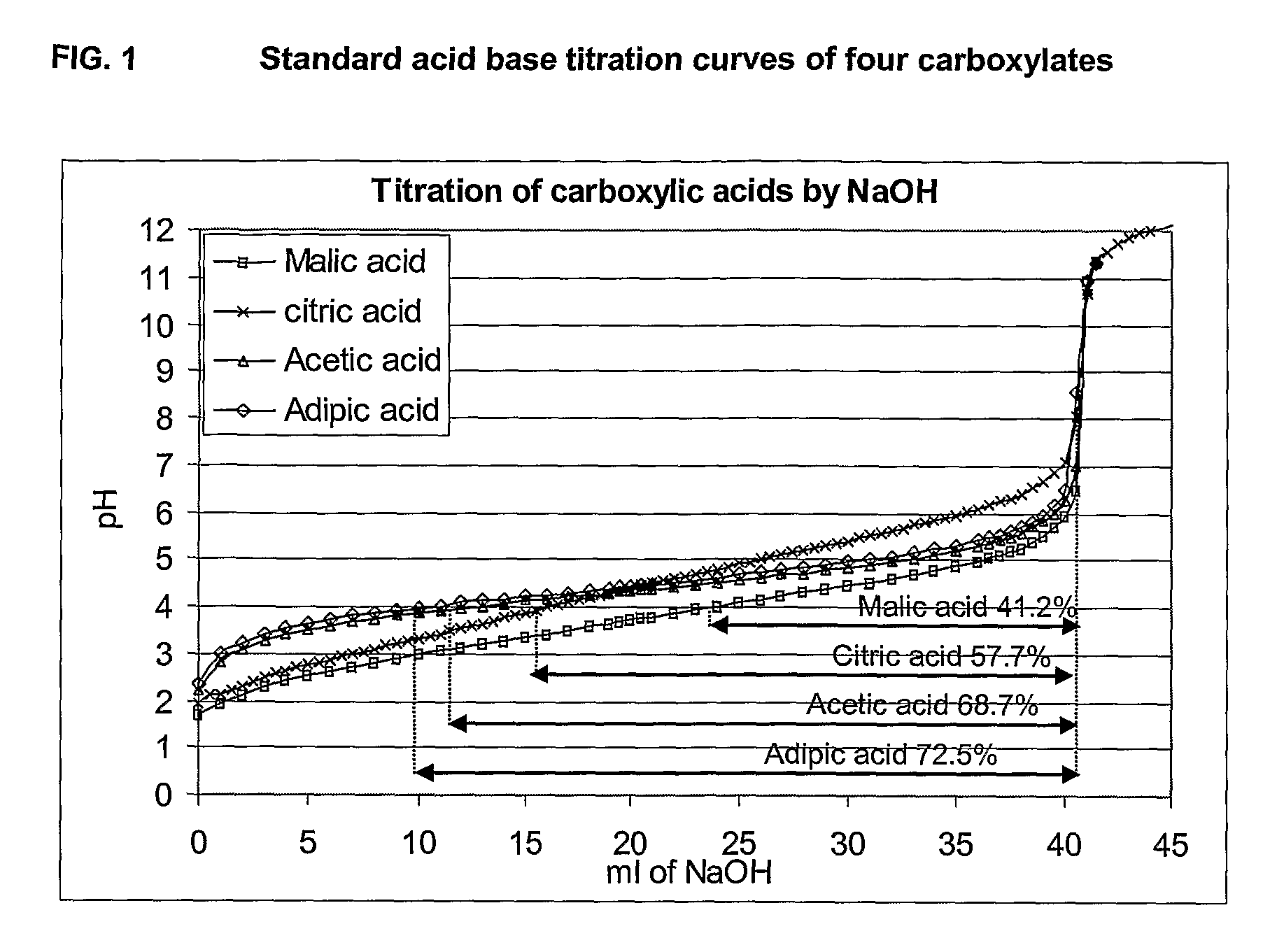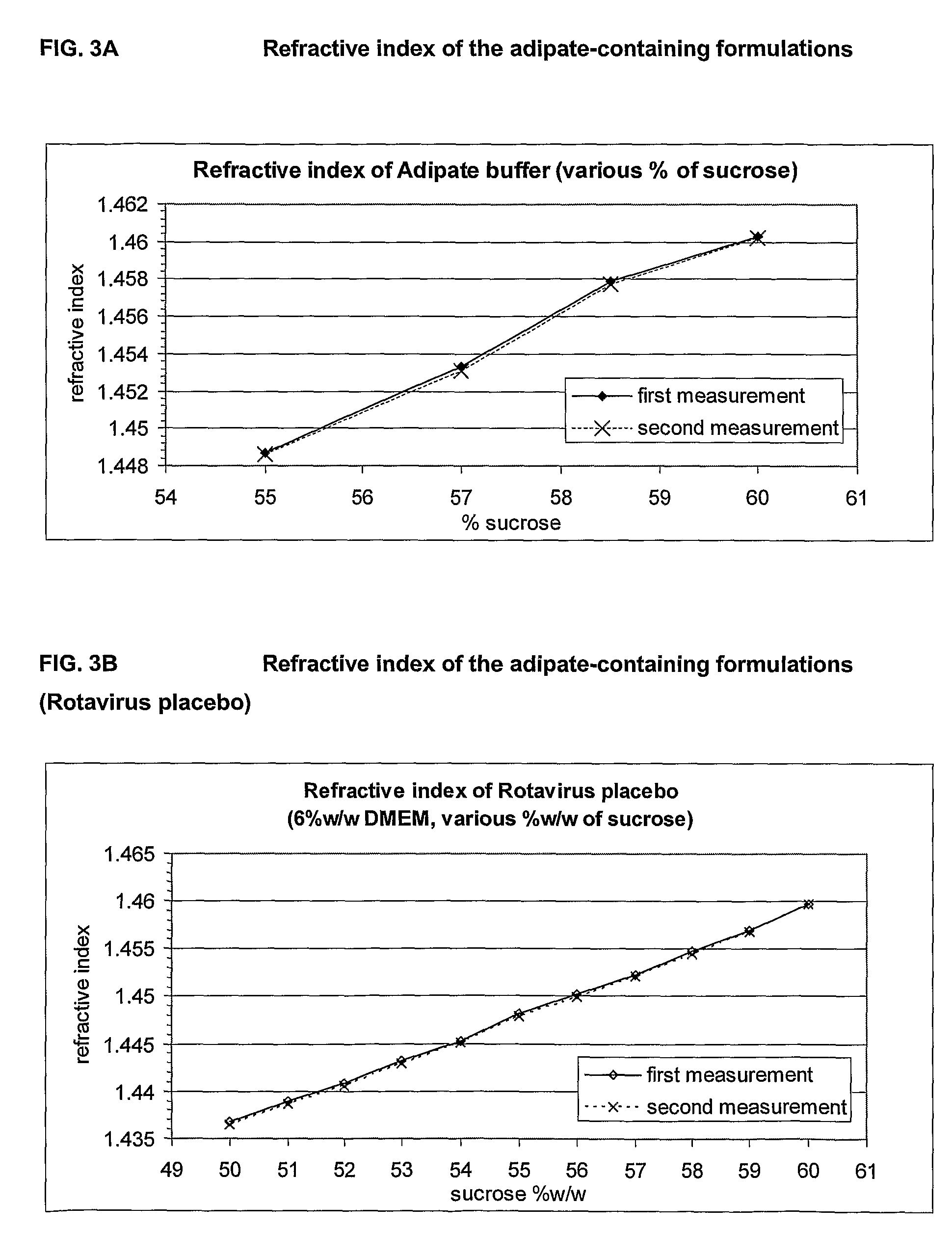Live attenuated rotavirus vaccine for oral administration
a rotavirus and liquid technology, applied in the field of liquid rotavirus formulations, can solve the problems of limiting capacity, high production cost, more sophisticated handling, etc., and achieve the effect of remaining immunogenic and stable over a long shelf li
- Summary
- Abstract
- Description
- Claims
- Application Information
AI Technical Summary
Benefits of technology
Problems solved by technology
Method used
Image
Examples
example i
Formulation of a Live Attenuated Human Rotavirus Liquid Vaccine i) in the Absence of Added Phosphate and Carboxylate, and ii) in the Presence of Citrate as a Carboxylate in the Absence of Added Phosphate
[0102]I.1. Preparation of the Formulations
[0103]I.1.1. Composition of the DMEM Medium (to Prepare 1 Litre of DMEM):
Water for injection: 0.8 liters
Dissolve Successively the Following Compounds:
Sodium chloride: 6.40 g
Potassium Chloride: 0.40 g
Magnesium Sulfate.7H2O: 0.20 g
Add iron nitrate solution at 0.1 g / L: 1.00 ml
NaH2PO4.2H2O: 0.1412 g
Sodium pyruvate: 0.11 g
Glucose anhydre: 4.50 g
[0104]Vitamin solution (500× concentrated): 2.00 ml
Water for injection: 1.50 ml
Chlorhydric acid (concentrated): 0.083 ml
L-Cystine: 0.048 g
L-Tyrosine: 0.072 g
Water for injection: 2.00 ml
Aminoacids solution: 20.00 ml
L-Glutamine: 0.5846
Calcium chloride.2H2O: 0.2649 g
Sodium bicarbonate: 3.70 g
Water for injection up to 1 liter
[0105]DMEM represents 5%, 6% or 8% of the formulations detailed in Example II. This cor...
example ii
Formulations with an Alternative Carboxylate Salt in the Absence of Added Phosphate
[0138]The following carboxylate salts have been used to create a buffer capacity: acetate, malonate, succinate, glutarate, adipate and malate. According to the pKa of a given carboxylic acid, and depending on its molecular weight, it is possible to find quantities to be formulated to achieve the target antacid capacity of at least 8 minutes, suitably at least 12 minutes as assessed by the BRR test, whilst being in a pH window of between pH 5.0 to pH 8.0.
[0139]Chemically speaking, a “buffer” effect is obtained when mixing a strong acid (like HCl) and a salt derived from a weak acid (like sodium acetate). The pH value corresponding to the middle of the buffer plateau is equal to the pKa of the weak acid. The pKa of carboxylic acid is a measure of acidic strength, in other words an indicator of the effective buffering range of the compound.
[0140]Since rotavirus is rapidly degraded below pH 4 (C. Weiss an...
example iii
Methods
[0297]III.1 Rotavirus Viral Titration
[0298]Detection of infectious rotaviruses is done by incubation of the formulation containing the rotavirus and various components on permissive MA104 cells (ATCC CRL 2378).
[0299]The Rotavirus (e.g. P43 rotavirus, ECACC 99081301) was formulated as described in the above examples. After inoculation of viral samples, the cells are incubated for 16 to 18 hours. The cells are then fixed and permeabilised with acetone 80%. Infected cells are identified by indirect immuno-fluorescence using a monoclonal anti-rotavirus antibody specific of the VP6 protein (Mab 9F6) detected by fluorescein-conjugated IgG and examined under UV microscope. Any commercially available monoclonal antibodies against rotavirus VP6 protein are suitable, and appropriate working dilutions will be determined by routine experimentation. For example the following monoclonals are suitable:[0300]RV 11-2 (IgG2a, ascites fluid conjugated with fluorescein isothiocyanate) from Rural...
PUM
| Property | Measurement | Unit |
|---|---|---|
| pH | aaaaa | aaaaa |
| pH | aaaaa | aaaaa |
| pH | aaaaa | aaaaa |
Abstract
Description
Claims
Application Information
 Login to View More
Login to View More - R&D
- Intellectual Property
- Life Sciences
- Materials
- Tech Scout
- Unparalleled Data Quality
- Higher Quality Content
- 60% Fewer Hallucinations
Browse by: Latest US Patents, China's latest patents, Technical Efficacy Thesaurus, Application Domain, Technology Topic, Popular Technical Reports.
© 2025 PatSnap. All rights reserved.Legal|Privacy policy|Modern Slavery Act Transparency Statement|Sitemap|About US| Contact US: help@patsnap.com



